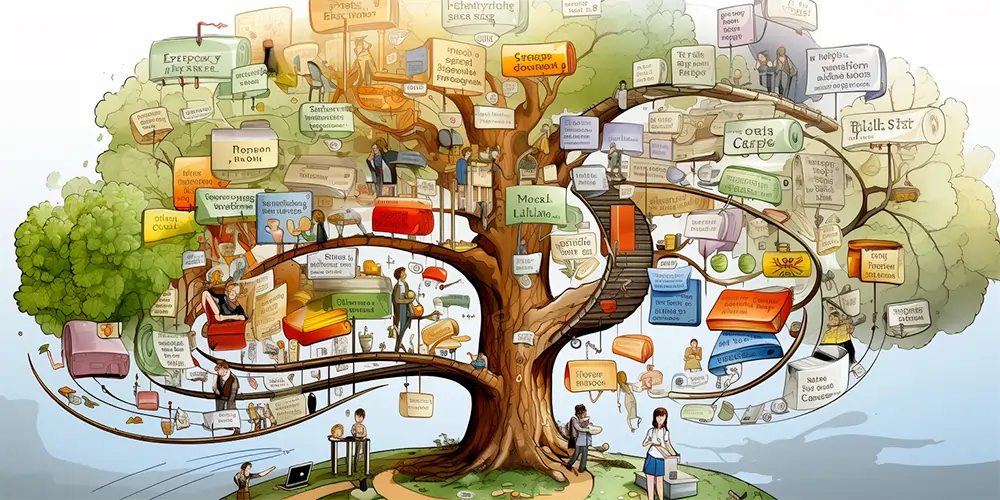A branch of artificial intelligence called “machine learning” focuses on creating statistical models and algorithms that let computers learn and make judgements or predictions without being explicitly programmed.
Machine learning systems identify patterns and make generalisations by analysing vast amounts of data, improving their performance over time.
Importance of Machine Learning in Modern Technology
Machine learning’s introduction has transformed many facets of contemporary technology, making it crucial in many applications.
In many industries, including healthcare, banking, and transportation, its capacity to analyse big datasets has increased efficiency, accuracy, and speed.
As a result, it’s transforming how we interact with technology and shapes the future of various fields.

How Machine Learning Works
Machine learning relies on a data-driven approach to identify patterns and make predictions.
It uses historical data to train and refine its models, allowing the system to make informed decisions or predictions based on the learned patterns.
Training Machine Learning Models
Training a machine learning model involves feeding it large amounts of data, often called the training dataset.
The model uses this data to learn and adjust its internal parameters, enabling it to recognise patterns and correlations within the data.
The quality of the training data directly influences the model’s performance, with more extensive and diverse datasets typically yield better results.
Making Predictions or Decisions Based on Learning
Once trained, a learning model may generate predictions or conclusions based on new, unexplored data.
The model generalises its learning from the training dataset to make inferences about the new data, which may involve classification, regression, or clustering tasks.
Comparison with Traditional Programming
In traditional programming, developers write explicit instructions for a computer to follow.
However, with these learning models, the system learns from data to make decisions or predictions without detailed programming.
This learning process allows machine learning models to adapt to new information and handle complex, unstructured data more efficiently than rule-based programming.
Types of Machine Learning
- Supervised Learning
Supervised learning is a type of machine learning where the model learns from labelled data.
In this approach, the training dataset includes input-output pairs, where the output, or “label,” is provided by a human expert.
The model uses this labelled data to learn the relationships between inputs and outputs, allowing it to make predictions on new, unlabelled data.
- Unsupervised Learning
On the other hand, unsupervised learning involves training a model without labelled data.
Instead, the model aims to identify patterns or structures within the input data itself.
Common unsupervised learning tasks include clustering, where the model groups similar data points, and dimensionality reduction, where the model reduces the number of features in the data to reveal hidden patterns.
- Reinforcement Learning
An agent learns to make decisions by interacting with its environment in a type of machine learning known as reinforcement learning.
The agent receives feedback in the form of rewards or penalties and adjusts its actions accordingly to maximise the cumulative rewards over time.
Reinforcement learning is beneficial when the ideal solution cannot be known beforehand and must be found through trial and error.

Applications of Machine Learning
Machine learning has a wide array of applications across numerous industries. The following are some notable examples:
Image Recognition
Image recognition, or computer vision, involves teaching a machine-learning model to identify and classify objects within images.
Face recognition, self-driving automobiles, and defect identification in manufacturing processes are just a few of the uses for this technology.
Natural Language Processing
Machine learning is used in natural language processing to analyse and comprehend human language.
NLP enables machines to perform sentiment analysis, machine translation, and text summarisation, enhancing communication between humans and computers.
Recommendation Systems
Recommendation systems use machine learning algorithms to provide users personalised content and product suggestions.
By analysing users’ behaviour, preferences, and historical data, these systems can predict what a user might be interested in, enhancing user experience and increasing engagement.
Common applications of recommendation systems include online shopping, video streaming services, and news platforms.
Fraud Detection
Learning models can identify patterns and anomalies in large datasets, making them well-suited for fraud detection tasks.
By analysing transaction data, machine learning algorithms can recognise unusual activities or behaviours, flagging potential fraud cases for further investigation.
This technology is precious in industries such as banking and insurance.
Medical Diagnosis
Machine learning has the potential to revolutionise healthcare by assisting in medical diagnosis.
ML algorithms can identify diseases, forecast treatment outcomes, and customise care plans by assessing medical imaging, electronic health records, and other patient data, ultimately improving patient outcomes and lowering healthcare costs.
Predictive Maintenance
Predictive maintenance is an application to predict when equipment or machinery is likely to fail, allowing for timely maintenance and reduced downtime.
Machine learning models analyse sensor data, maintenance records, and other relevant information to estimate the remaining useful life of equipment, optimising maintenance schedules and preventing unplanned failures.

Machine Learning vs Artificial Intelligence
Defining Artificial Intelligence
Artificial intelligence is a vast area within computer science that focuses on designing systems capable of carrying out tasks that generally need human intelligence.
These tasks involve problem-solving, learning, reasoning, sensing, and comprehending natural language.
There are several approaches to achieving AI, such as machine learning, rule-based, and expert systems.
Machine Learning as a Subset of AI
Machine learning is a specialised branch of AI that creates algorithms and models that empower machines to learn and enhance their performance without needing direct programming.
In other words, machine learning represents a specific approach to AI, emphasising data-driven learning and adaptation rather than pre-defined rules and instructions.
Differences Between Machine Learning, Rule-Based Systems, and Expert Systems
Although machine learning, rule-based systems, and expert systems belong to the broader AI category, they have unique differences.
Machine learning: As mentioned before, it depends on learning from data, where models are taught to identify patterns and make forecasts or choices based on past data.
These models can adjust and enhance their performance over time as they encounter new data.
Rule-Based Systems: Also referred to as knowledge-based systems, use a preset set of rules and heuristics to solve issues or make choices.
These systems are created by encoding human expertise and domain knowledge into a series of rules, which the system then applies to reason and make decisions.
They do not learn or adapt independently, making them less flexible than machine learning models.
Expert Systems: Expert systems are rule-based systems that mimic a human expert’s decision-making abilities in a specific domain.
These systems rely on domain experts’ knowledge of facts and heuristics to draw inferences and make recommendations.
While expert systems can be highly effective in their specific domains, they are limited by their reliance on pre-defined rules and need more adaptive capabilities of ML models.

How Machine Training Works
Developing a machine learning system typically involves several key steps, which are outlined below:
- Data Collection and Preparation
Collecting data entails obtaining unprocessed information from various sources like databases, sensors, or user content.
Data preparation, sometimes called data preprocessing, involves the process of cleaning, modifying, and arranging the collected data to guarantee its readiness for training a ML model.
This step may involve handling missing values, removing outliers, and normalising or scaling data.
- Model Selection
Model selection involves choosing the appropriate machine-learning algorithm for the specific problem or task.
This choice depends on factors such as the data’s type and size, the problem’s complexity, and the desired level of interpretability or performance.
Examples of machine learning algorithms encompass decision trees, support vector machines, and neural networks.
- Model Training
Model training feeds the prepared data into the selected machine-learning algorithm.
During training, the model learns and adjusts its internal parameters based on the data, enabling it to recognise patterns and relationships within the data.
The quality of the training data directly influences the model’s performance, with more extensive and diverse datasets typically yield better results.
- Model Evaluation
Model evaluation involves assessing the performance of the trained machine-learning model using various metrics and techniques.
This step is crucial to ensure the model is accurate, robust, and generalisable to new, previously unseen data.
Common evaluation methods include cross-validation and hold-out validation, while performance metrics may include accuracy, precision, recall, and F1 score.
- Model Deployment
After the machine learning model has undergone training and evaluation, it can be implemented for practical, real-world applications.
Deployment involves integrating the model into a more extensive system or application, allowing it to make predictions or decisions based on new data.
This step may also involve creating an API or user interface to interact with the model and implementing monitoring and logging systems to track its performance.
- Model Updating and Retraining
Machine learning models may require updating and retraining to maintain performance, especially when the underlying data or problem domain changes.
This procedure entails gathering new data, reassessing the model’s performance, and, if needed, retraining the model.
Regularly updating and retraining a model helps ensure its continued accuracy and relevance, allowing it to adapt to new information and evolving problem domains.

Potential of Machine Learning Technology
Machine learning technology has the potential to revolutionise countless industries and domains, offering unprecedented insights and automation capabilities.
By harnessing the potential of data, these models can enhance decision-making, streamline processes, and provide tailored experiences. This results in heightened efficiency, reduced costs, and improved user satisfaction.
Responsibility in Developing and Deploying Machine Learning Systems
With the increasing adoption of these systems, it’s vital to acknowledge the significance of responsible development and implementation.
Ensuring these systems are transparent, fair, and accountable helps mitigate potential issues such as bias, discrimination, and privacy concerns.
Developers, researchers, and stakeholders must work together to create guidelines and best practices that prioritise ethical considerations, fostering trust and confidence in machine learning technology.
Future Applications and Ethical Considerations
As machine learning advances and evolves, new applications and possibilities will undoubtedly emerge.
Finding the right balance between embracing innovation and staying true to ethical values is essential. It ensures that as technology advances, it remains grounded in human principles and works towards the betterment of society.
By fostering a responsible approach to machine learning, we can harness its potential to transform industries and improve lives while upholding our commitment to fairness, transparency, and accountability.




